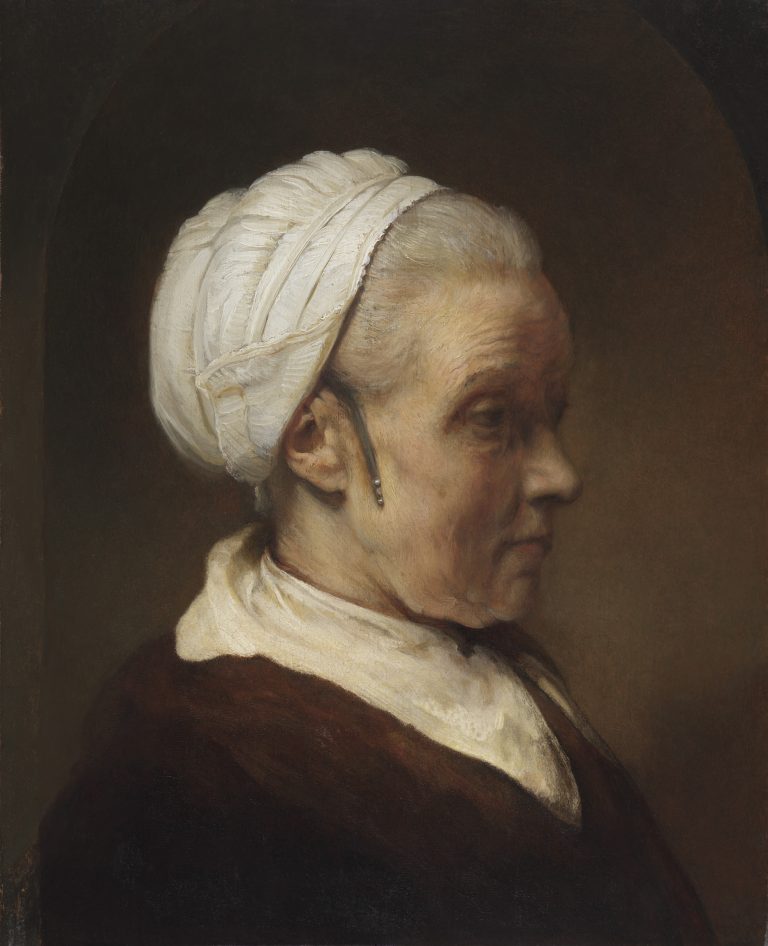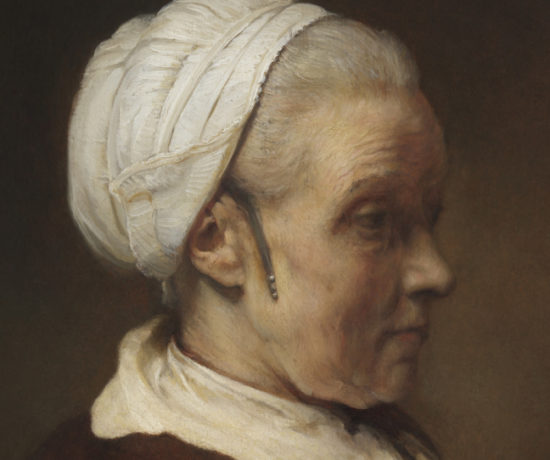This moving profile depiction of a mature woman wearing a white cap occupies an unusual place within Rembrandt van Rijn’s painted oeuvre. Although clearly representing a specific individual, the master seems not to have conceived this painting as a formal portrait; instead, the woman’s focused gaze and raised eyebrows make it appear as though she has been plucked from the stream of her daily responsibilities. Moreover, her flat plain collar identifies her as a servant who would have occupied a social position far beneath those who could afford to sit for Rembrandt around 1640, when he executed this work. Rembrandt seems to have concerned himself here primarily in determining how the effects of direct and reflected light affect the characterization of the figure in such a study. Light strikes the woman’s head from behind while reflected light illuminates her face. Rembrandt enhanced these light effects through his different levels of finish, ranging from fully built-up paint on her cap, forehead and cheek to the more thinly and loosely executed shaded areas.
Throughout much of its history, this work had a different appearance. By the mid-nineteenth century, several areas of the painting had been reworked in an effort to recast it as a formal portrait (fig 1). The plain collar had been painted out in a decisive manner by a later hand: an intervening layer of black was used to ensure it was covered completely before a more stylish fur collar was painted in its place. Notably, however, the oorijzer, or “ear iron,” was left fully visible. This metal band was fitted inside the bonnet to hold it in place around the head and over the ear, and was normally hidden behind the earflap of the bonnet. The fact that this metal band was left visible when the repainting was done suggests that its function was not recognized and that it was believed to be characteristic of normal dress.
When this painting first entered the literature (in its altered state), it was included in the master’s oeuvre without any reservations. John Smith was the first to cite it in 1836,1 and his positive assessment was subsequently reaffirmed in the early twentieth century by Cornelis Hofstede de Groot, Max Friedländer, Hermann Voss, and Abraham Bredius.2 Wilhelm Valentiner was particularly vigorous in his support in publications of 1921, 1930, and 1931.3 A change in judgment occurred in 1936, when Abraham Bredius abandoned his earlier position and omitted the panel from his catalogue of Rembrandt’s paintings.4 No scholar subsequently challenged this sidelining of the painting until Ernst van de Wetering’s reassessments in 2005 and 2006, subsequent to the conservation of the painting by Martin Bijl in 2003–5.5
Van de Wetering initially focused his discussion on the physical adjustment of the panel and later overpainting that had transformed this head study into a formal portrait. Aside from the overpainting of the color, additions had been made to the panel’s original arched upper corners to create a rectangular format conventional for portraits.6 The detail of the ear iron is further evidence of the informal nature of this work; indeed, the only other instance of its exposure in a Dutch painting is in a genre scene by Rembrandt’s follower Philips Koninck (fig 2). The similarity of the presentation of this feature suggests that Koninck followed Rembrandt’s painting as a model, and thus may have seen it in Rembrandt’s studio.
Although the conservation treatment revealed that areas of the face had been overcleaned, Van der Wetering pointed to the remarkably strong passages in the cap, ear and ear iron, as well as in the cheek and jaw, as exemplary of Rembrandt’s unique ability to model forms by using a combination of loose and rhythmic paint handling. The relative softness of the shaded parts of the face, Van der Wetering rightly argued, was consistent with Rembrandt’s approach to such study heads.
Rembrandt’s interest in rendering this woman’s face in indirect light may relate to an artistic challenge he was facing around 1640 in planning his double portrait of Cornelis Claesz Anslo and his wife of 1641 (fig 3). The interaction of these two conversing figures required that one face would be cast in shadow—in this case, the man’s—while the other was lit. In both works Rembrandt sought to balance a convincing rendering of the effect of strong light with a wide range of modulated shadows and reflected light. These latter effects are particularly evident in Study of a Woman in a White Cap in the middle tones of reflected light on the nose, cheeks, chin and forehead.
Dendrochronological analysis of the oak panel support relates this painting to three other works from Rembrandt’s workshop, each of which was painted on a panel from the same tree.7 These comprise the authentic Self-Portrait of 1633,8 Portrait of a Man (formerly identified as Willem Burggraeff), likely not autograph,9 and a landscape of around 1640 in the Wallace Collection, certainly by a pupil.10 Van de Wetering has argued that the Leiden Collection painting similarly dates to around 1640. He notes not only its connection to the Berlin double portrait but also to a cluster of other works painted at this time that likewise demonstrate a combination of loose and regular handling, such as Still Life with Two Dead Peacocks and a Girl,11 Hunter with a Dead Bittern,12 and Landscape with a Stone Bridge.13
In each of these other works of about 1640, Rembrandt extended his range of style and subject matter beyond conventional pictorial types. In the same experimental spirit he made the cap, the ear iron, and the woman’s cheek the focal points of this portrait-like study, defining them with solidity and brilliance only he commanded. While this painting served Rembrandt primarily as a study, and perhaps also as a teaching demonstration of an evocative lighting scenario, he also seized the chance to suggest his subject’s inner fortitude in her unfazed, slightly humored expression. It is also possible that this powerful image served as a demonstration to a prospective portrait client of the effective presentation of a head with the face in shadow. All of these considerations indicate the significance of Study of a Woman in a White Cap for Rembrandt and his oeuvre. This compelling image is also of great significance for the Leiden Collection, for it is the first painting by Rembrandt to enter this collection.

